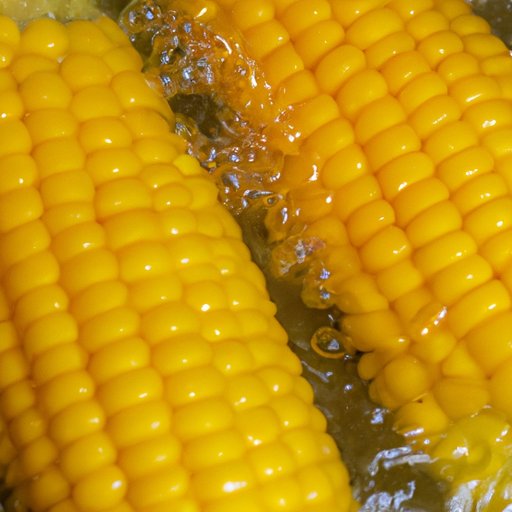I. Introduction
Corn on the cob is a staple side dish for many meals, including barbecue, picnics, and family dinners. However, boiling corn on the cob can be a challenge for those who are unfamiliar with this cooking method. In this article, we will provide a step-by-step guide to boiling corn on the cob, as well as discuss its health benefits, flavor variations, and cooking comparisons with other methods.
II. Step-by-Step Instructions
Boiling corn on the cob is easy and straightforward, requiring only a few basic tools. Here is what you need to do:
- Take a large pot and fill it with enough water to fully cover the corn.
- Place the pot on the stove over high heat and allow the water to come to a rolling boil.
- While waiting for the water to boil, shuck the corn and remove the silk.
- Once the water is boiling, carefully add the corn to the pot using tongs.
- Allow the corn to cook for 8-12 minutes, depending on how tender you prefer your corn.
- Remove the corn from the pot using tongs and place it on a plate or platter.
- Season the corn with salt, pepper, and butter to taste.
It is important to note that the timing for boiling corn on the cob can vary depending on the altitude, type of corn, and preferred level of tenderness. It is recommended to start with 8 minutes and check for doneness by inserting a fork into the kernels. If you prefer softer kernels, allow the corn to boil for an additional 2-4 minutes.
III. Health Benefits of Corn
Corn is a nutritious and healthy side dish, providing a variety of vitamins, minerals, and antioxidants. It is also a good source of fiber and low in fat and calories. By boiling corn on the cob, you can enjoy the benefits of this nutritious vegetable without adding any extra fat or calories.
IV. Flavor Variations
While salt, pepper, and butter are classic seasoning choices for corn on the cob, there are many other delicious flavor combinations to try. Here are a few suggestions:
- Parmesan cheese and herbs
- Chili lime and cumin
- Garlic and butter
- Feta cheese and oregano
Experiment with your favorite spices and herbs to create your unique blend of flavors.
V. Comparison of Cooking Methods
While boiling is the most popular and traditional method for cooking corn on the cob, there are other ways to prepare it. Grilling or roasting corn on the cob can add a smoky flavor and charred texture to the kernels. However, these methods often require more preparation and may not produce consistent results. Boiling corn on the cob is a preferred method for its ease and reliability.
VI. Historical Significance
Corn on the cob has a long history in many cultures, including Native American and Mexican cuisine. The Aztec and Mayan civilizations used corn as a staple food source, and corn on the cob was later introduced to European settlers. Many traditional methods of boiling corn on the cob have been passed down through generations, such as adding sugar to the water or cooking it over an open fire.
VII. Cooking with Corn
If you happen to have leftovers, boiled corn on the cob can be a great addition to other recipes. Try adding it to a salad, salsa, or soup for added flavor and nutrition. Here are two recipes that use boiled corn on the cob:
- Corn Salsa: Combine chopped tomatoes, red onion, jalapeno, cilantro, and corn kernels in a bowl. Season with lime juice, salt, and pepper.
- Corn Chowder: Sauté diced onion and celery in a pot until tender. Add diced potatoes, chicken broth, and boiled corn on the cob kernels. Simmer until the potatoes are soft, then blend the mixture until smooth. Serve with crumbled bacon and chives.
VIII. Troubleshooting Tips
While boiling corn on the cob is relatively easy, there are some common mistakes to avoid. Here are a few tips:
- Do not overcook the corn, or it will become mushy and lose its texture.
- Do not undercook the corn, or it will be tough and chewy.
- Do not add salt to the water, as it can toughen the corn.
- Do not overcrowd the pot, or the corn will not cook evenly.
- Do not forget to season the corn after boiling.
IX. Conclusion
Boiling corn on the cob is a simple and delicious way to enjoy this nutritious vegetable. By following our step-by-step guide, experimenting with different flavor combinations, and learning about its cultural significance, you can elevate your corn on the cob game.
